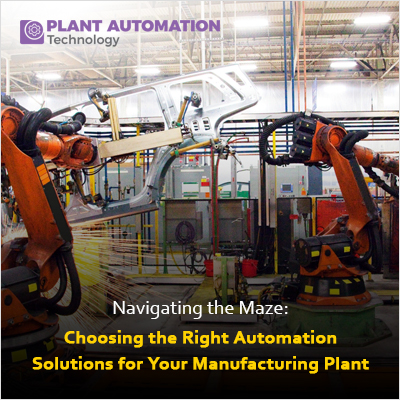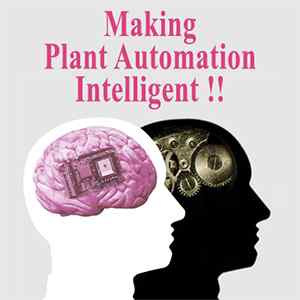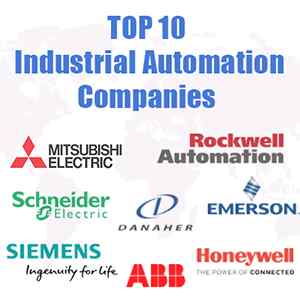Navigating the Maze: Choosing the Right Automation Solutions for Your Manufacturing Plant

Introduction:
In the dynamic realm of manufacturing, the adoption of automation solutions stands as a pivotal catalyst for enhanced efficiency, heightened productivity, and sustained competitiveness. Selecting the appropriate automation solutions for your manufacturing plant is a decision of paramount significance, necessitating a meticulous examination of various factors. In this comprehensive exploration, we will delve into the key elements to guide you in making well-informed decisions and articulating complex concepts in a language accessible to all.
Understanding Your Needs:
Before embarking on the journey of automation, a foundational step involves gaining a crystal-clear comprehension of your manufacturing plant's requisites. Pinpoint the specific processes poised to benefit from automation, whether it be the optimization of assembly lines, fortification of quality control measures, streamlining material handling, or even the orchestration of seamless inventory management.
In addition to immediate needs, consider the scalability of the chosen solution to accommodate future growth and adaptability to changes in production volume. Evaluate the existing skill set of your workforce, and concurrently, gauge the level of training required for them to seamlessly assimilate into the new automated processes.
Types of Automation Solutions:
1. Robotic Automation:
Robotic solutions represent a versatile and transformative force within manufacturing. Ranging from handling repetitive assembly tasks to intricate material maneuvering, robots play a pivotal role in redefining operational efficiency. When selecting robotic systems, it's imperative to consider factors such as payload capacity, reach, and speed. Moreover, the advent of collaborative robots, or cobots, offers the unique advantage of working harmoniously alongside human operators, infusing a new dimension of flexibility onto the production floor.
2. Industrial Internet of Things (IIoT):
The Industrial Internet of Things (IIoT) heralds a new era in manufacturing by interconnecting machines and devices. This interconnectedness facilitates the gathering and analysis of data, enabling smarter decision-making. Through the strategic deployment of sensors and smart devices, manufacturing plants can monitor equipment health, predict maintenance needs, and optimize energy consumption. The integration with cloud platforms further empowers real-time data access and analysis, fostering a data-driven approach to decision-making.
3. Automated Guided Vehicles (AGVs):
Automated Guided Vehicles (AGVs) represent a mobile solution for material transportation within manufacturing plants. These vehicles, equipped with navigation capabilities, can operate autonomously using sensors or adhere to predefined paths, thereby minimizing the need for manual handling and transportation. The deployment of AGVs enhances efficiency in material logistics, reducing operational bottlenecks and augmenting overall productivity.
4. Computer Numerical Control (CNC) Systems:
For precision manufacturing, Computer Numerical Control (CNC) systems stand as stalwart allies. These systems automate machine tools, ensuring the production of intricate components with unparalleled accuracy. When contemplating CNC systems, it is crucial to evaluate compatibility with existing machinery and the complexity of the parts manufactured. An adeptly chosen CNC system can optimize production processes, elevate product quality, and contribute to the overall efficiency of the manufacturing plant.
5. Vision Systems and Machine Learning:
Vision systems, augmented by machine learning, offer sophisticated solutions for tasks such as quality control and object recognition. Leveraging cameras and advanced image processing techniques, vision systems can detect defects, assess product quality, and contribute to the maintenance of stringent production standards. As machine learning algorithms continue to evolve, these systems become adaptive, learning from experience and continuously improving accuracy and efficiency over time.
Choosing the Right Solution:
1. Cost-Benefit Analysis:
A crucial factor in choosing automation solutions involves conducting an extensive cost-benefit analysis. This process encompasses the assessment of not just the initial implementation costs but also the potential return on investment (ROI) over an extended period. Although the upfront investment might appear significant, the enduring benefits, such as savings in labor costs, heightened production speed, and diminished error rates, frequently validate and exceed the initial expenses.
2. Ease of Integration:
Seamless integration with existing infrastructure is a critical criterion for choosing automation solutions. Disruptions to ongoing production processes during the implementation phase should be minimized. Opt for solutions that can be smoothly integrated with your current setup, ensuring a harmonious transition to automated processes without compromising operational continuity.
3. Scalability:
The scalability of chosen automation solutions is paramount, especially in the dynamic landscape of manufacturing. Opt for solutions that can seamlessly grow with your business, accommodating future expansions and adjustments in production scale. A scalable automation infrastructure ensures that your initial investment continues to provide value as your manufacturing plant evolves.
4. User-Friendly Interface:
The success of automation implementation is closely tied to the user-friendliness of the chosen solutions. An intuitive interface and controls that are easily understandable to your workforce reduce the learning curve, ensuring swift and effective adoption of automated processes. Prioritize solutions that empower your workforce, allowing them to leverage automation as a tool to enhance their capabilities and contribute to overall operational excellence.
Conclusion:
In the panorama of modern manufacturing, the strategic adoption of automation solutions is not merely a choice but a necessity for staying competitive and thriving in a dynamic marketplace. The journey towards choosing the right automation solutions entails a meticulous exploration of needs, an understanding of available technologies, and a judicious evaluation of various factors.
By comprehensively understanding the needs of your manufacturing plant, exploring the diverse landscape of automation solutions, and carefully considering factors such as cost, ease of integration, scalability, and user-friendliness, you can make informed decisions that have a transformative impact on your production efficiency and overall business success.
Embrace automation not just as a technological upgrade but as a tool to empower your workforce, elevate operational processes, and position your manufacturing plant at the forefront of innovation. As you navigate the maze of automation choices, envision a future where human ingenuity collaborates seamlessly with technological prowess, propelling your manufacturing endeavors to new heights of efficiency and excellence.







